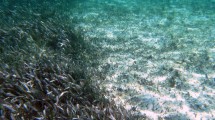Abstract
The capacity of seagrass canopies to directly retain sestonic particles was tested by quantifying the rate at which suspended fluorescent tracer particles were retained within a tropical Philippine seagrass meadow and by examining whether the test particles lost from the water column were later bound to seagrass leaves or inside epibionts. The particle loss rates in the presence of seagrass canopies were up to 4 times higher than those in unvegetated and plankton controls. The seagrass canopies trapped particles with a maximum rate of 0.73 (±0.24) h−1. As much as 5% of the particles trapped by the seagrass leaves were physically adhered to the leaf surfaces following rinsing. Particles were also observed to be ingested by protozoa (ciliates and amoeba-like organisms), residing on the surface of the leaves, and may be the dominant particle trapping mechanism by seagrass leaves. These processes should provide an efficient mechanism for the transfer of planktonic production to the benthos, adding to the high organic carbon input maintained by the high production of the seagrass themselves.
Similar content being viewed by others
Literature Cited
Ackerman, J. D. andA. Okubo. 1993. Reduced mixing in a marine macrophyte canopy.Functional Ecology 7:305–309.
Agawin, N. S. R., C. M. Duarte, S. Agustí, and L. McManus. In press. Abundance, biomass and growth rates ofSynechococcus sp. in a tropical coastal ecosystem (Philippines, South China Sea).Estuarine, Coastal and Shelf Science.
Agawin, N. S. R., C. M. Duarte, andM. D. Fortes. 1996. Nutrient limitation of Philippine seagrasses (Cape Bolinao, NW Philippines): In situ experimental evidence.Marine Ecology Progress Series 138:233–243.
Agawin, N. S. R., C. M. Duarte, M. D. Fortes, J. Uri, andJ. E. Vermaat. 2001. Temporal changes in the abundance, leaf growth and photosynthesis of three co-occurring Philippine seagrasses.Journal of Experimental Marine Biology and Ecology 260:217–239.
Cambridge, M. L. andA. J. McComb. 1986. The loss of seagrass from Cockburn Sound, Western Australia. II. Possible causes of seagrass decline.Aquatic Botany 24:269–285.
Dennison, W. C., R. J. Orth, K. A. Moore, J. C. Stevenson, V. Carter, S. Kollar, P. W. Bergstrom, andR. Batiuk. 1993. Assessing water quality with submersed aquatic vegetation.Bioscience 43:86–91.
Duarte, C. M. 1995. Submerged aquatic vegetation in relation to different nutrient regimes.Ophelia 41:87–112.
Duarte, C. M., J. Uri, N. S. R. Agawin, M. D. Fortes, J. E. Vermaat, andN. Marbá. 1997. Flowering frequency of Philippine seagrasses.Botanica Marina 40:497–500.
Gacia, E. andC. M. Duarte. 2001. Sediment retention by a Mediterranean Posidonia oceanica meadow: The balance between deposition and resuspension.Estuarine, Coastal and Shelf Science 52:505–514.
Gacia, E., T. C. Granata, andC. M. Duarte. 1999. An approach to measurement of particle flux and sediment retention within seagrass (Posidonia oceanica) meadows.Aquatic Botany 65: 255–268.
Gambi, M. C., A. R. M. Nowell, andP. A. Jumars. 1990. Flume observations on flow dynamics inZostera marina (eelgrass) beds.Marine Ecology Progress Series 61:159–169.
Giesen, W. B. J. T., M. M. van Katwijk, andC. den Hartog. 1990. Eelgrass condition and turbidity in the Dutch Wadden Sea.Aquatic Botany 37:71–85.
Hemminga, M. A. andC. M. Duarte. 2000. Seagrass Ecology. University Press, Cambridge, U.K.
Koch, E. W. 1996. Hydrodynamics of a shallowThalassia testudinum bed in Florida, USA, p. 105–110.In J. K. Kuo, R. C. Phillips, D. I. Walker, and H. Kirkman (eds.). Proceedings of the International Seagrass Biology Workshop, Rottnest Island, Perth, Australia.
Lemmens, J. W. T. J., G. Clappin, P. Lavery, andJ. Cary. 1996. Filtering capacity of seagrass meadows and other habitats of Cockburn Sound, Western Australia.Marine Ecology Progress Series 143:187–200.
Lubel, A. A. andE. Murillo. 1999. Epibiotic protozoa (Ciliophora) on a community ofThalassia testudinum Banks ex König in a coral reef in Veracruz, Mexico.Aquatic Botany 65: 239–254.
Sand-Jensen, K. andJ. Borum. 1991. Interactions among phytoplankton, periphyton, and macrophytes in temperate freshwaters and estuaries.Aquatic Botany 41:137–176.
Sherr, E. B. andB. F. Sherr. 1993a. Protistan grazing rates via uptake of fluorescently labeled prey, p. 695–701.In P. F. Kemp, B. F. Sherr, E. B. Sherr, and J. J. Cole (eds.), Handbook of Methods in Aquatic Microbial Ecology. Lewis Publishers, Boca Raton, Florida.
Sherr, E. B. andB. F. Sherr. 1993b. Preservation and storage of samples for enumeration of heterotrophic protists, p. 207–212.In P. F. Kemp, B. F. Sherr, E. B. Sherr, and J. J. Cole (eds.). Handbook of Methods in Aquatic Microbial Ecology. Lewis Publishers, Boca Raton, Florida.
Sokal, R. R. andF. J. Rohlf. 1981. Biometry, 2nd edition. W. H. Freeman and Company, New York.
Terrados, J. andC. M. Duarte. 2000. Experimental evidence of reduced particle resuspension within a seagrass (Posidonia oceanica L.) meadow.Journal of Experimental Marine Biology and Ecology 243:45–53.
Vaulot, D., F. Partensky, J. Neveux, R. F. C. Mantoura, andC. A. Llewellyn. 1990. Winter presence of prochlorophytes in surface waters of the northwestern Mediterranean Sea.Limnology and Oceanography 35:1156–1164.
Vermaat, J. E., N. S. R. Agawin, C. M. Duarte, M. D. Fortes, N. Marbá, andJ. Uri. 1995. Meadow maintenance, growth and productivity of a mixed Philippine seagrass bed.Marine Ecology Progress Series 124:215–225.
Ward, L. G., W. G. Kemp, andW. R. Boynton. 1984. The influence of waves and seagrass communities on suspended particulates in an estuarine embayment.Marine Geology 59:85–103.
Worcester, S. E. 1995. Effects of eelgrass beds on advection and turbulent mixing in low current and low shoot density environments.Marine Ecology Progress Series 126:223–232.
Zimmerman, R. C., J. L. Reguzzoni, S. Wyllie-Echeverria, M. Josselyn, andR. S. Alberte. 1991. Assessment of environmental suitability for growth ofZostera marina L. (eelgrass) in San Francisco Bay.Aquatic Botany 39:353–366.
Author information
Authors and Affiliations
Corresponding author
Rights and permissions
About this article
Cite this article
Agawin, N.S.R., Duarte, C.M. Evidence of direct particle trapping by a tropical seagrass meadow. Estuaries 25, 1205–1209 (2002). https://doi.org/10.1007/BF02692217
Received:
Accepted:
Issue Date:
DOI: https://doi.org/10.1007/BF02692217




